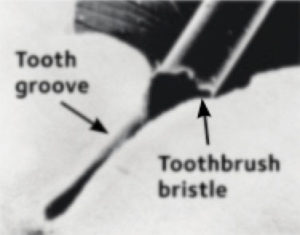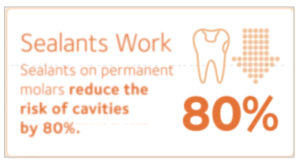
DENTAL SEALANTS ARE AN EASY WAY TO HELP KEEP TEETH HEALTHY
A dental sealant is a thin plastic coating that is put on the chewing surfaces of the back teeth. The sealant material flows into the pits and grooves on those surfaces and acts like a barrier, protecting enamel by “sealing out” bacteria and bits of food that can cause tooth decay.
It is better to prevent tooth decay with sealants than to treat decay after it has already formed. Sealants are very useful in preventing tooth decay on the back teeth and can save you money over time.
Sealants are a safe, painless and easy way to help protect your teeth and keep them healthy. This brochure explains how.
SEALANTS HELP PREVENT TOOTH DECAY AND CAVITIES
Your teeth are coated with a sticky film of bacteria, called plaque (pronounced PLACK). Bacteria in plaque turn sugar in what you eat and drink into acids. These acids can break down the hard, outer layer of teeth, called enamel (e-NAM-uhl). Over time, acid can weaken enamel and may cause tooth decay, or form a hole (cavity) in your tooth’s enamel.
Tooth decay often begins on the chewing surfaces of the back teeth. These surfaces have pits and grooves where plaque, bacteria and bits of food can get trapped. Just like in the pictures below, toothbrush bristles can’t reach into the pits and grooves, and that makes it hard to keep them clean. Your dentist may recommend dental sealants to keep decay from starting on these chewing surfaces in the pits and grooves.
Nine out of ten cavities children get are on their permanent back teeth. Sealants can prevent most of these cavities by keeping out bits of food and stopping bacteria and acid from settling on teeth.
The chewing surfaces of a molar (magnified) have pits and grooves that trap plaque and bits of food.
Even a toothbrush bristle is too big to reach inside a groove in the tooth (magnified).
Sealants are not a substitute for cleaning your teeth every day! They only help prevent decay if you stick to your daily oral hygiene routine.
SEALANTS ARE SAFE AND EFFECTIVE
Research shows that dental sealants are safe and effective. According to the Centers for Disease Control (CDC), children ages 6 to 11 without sealants have almost three times more cavities than children with sealants.
The American Dental Association (ADA) recommends dental sealants to lower your risk of tooth decay and cavities. If you have any questions, talk to your dentist.
SEALANTS ARE EASY TO APPLY
It takes only a few minutes for your dentist to seal each tooth. These are the steps your dentist may use to put sealants on your teeth:
- Your tooth is cleaned and the chewing surface is prepared to help the sealant material stick to your tooth.
- The sealant is painted onto the chewing surface where it bonds to your tooth and hardens.
- A special light may be used to help the sealant harden.
Sealants are smooth and you can’t feel them on your teeth. They are usually clear or white and can’t be seen when you smile or talk.
SEALANTS CAN LAST SEVERAL YEARS
Sealants usually last several years before they need to be replaced. Over time, sealants can come off, which means they may not protect the teeth as well. Chewing on ice or hard foods can also break down sealants.
During regular dental visits, your dentist will check your sealants and can reapply them if needed.
YOU MAY BENEFIT FROM SEALANTS AT ANY AGE
Sealants are recommended for children and teenagers because tooth decay can start soon after teeth come in. But, you never outgrow the chance of developing tooth decay and cavities, so adults can benefit from sealants, too.
A sealant can be placed on a tooth that does not have a cavity in its pits and grooves. If your tooth is stained or has slight decay, your dentist may suggest you get a sealant, though other treatment may be necessary. If your tooth has more severe decay or has a cavity, it may need a more advanced treatment like a filling.



